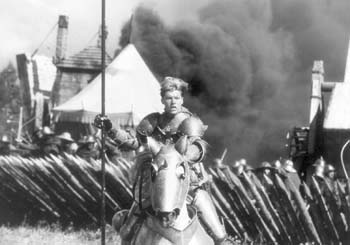![[Metroactive Movies]](/movies/gifs/movies468.gif)
[ Movies Index | Show Times | San Jose | Metroactive Central | Archives ]
 Photograph by Pat Kirk Maid of Destiny: Milla Jovovich rides to glory as Joan of Arc in 'The Messenger.' Nothing Much at Stake Milla Jovovich stars as Joan of Arc, medieval riot grrrl IN HIS PREFACE to his 1924 play Saint Joan, George Bernard Shaw weighs the many different Joan of Arcs given to us by history, the church and the romancers. One of the dangers of telling her story in an age of science, he suggests, is the temptation to portray the Maid of Orleans as a poor, deluded girl: "Let us then for once drop all nonsense about Joan being cracked." In The Messenger: The Story of Joan of Arc, director Luc Besson (The Fifth Element) and scriptwriter Andrew Birkin (The Cement Garden) have made Joan screaming, quivering, pinwheel-eyed, blacking-out insane. She takes her path to glory stimulated by a childhood trauma: a narrow escape from a raping English soldier; she recovers reality during therapy sessions with a character playing her Conscience (Dustin Hoffman, insufferably smooth, like a $100-an-hour Manhattan psychiatrist). Joan's insanity seems demonstrable when she decides to trust John Malkovich. As the Dauphin Charles, Malkovich is as slippery as always, complemented by an equally sinister mother-in-law dearest, Faye Dunaway. She's baldheaded with a blue vein coasting down her forehead that makes her look like a cracked egg. Both disappear two-thirds of the way through the film. Birkin's script doesn't contain any laughable anachronisms, with one exception. The raping English soldier looks over a peasant woman and huffs, "That's what I call booty!" The English are the villains, exactly the same kind of villains they are in Braveheart: bikers without bikes. The Messenger is historically accurate in that it doesn't pin the death of Joan on the Catholic Church, but Besson gets a laugh from the audience (which sorely needs one) by pointing out that it took the church 500 years to make her a saint. Joan, however, doesn't do anything saintly here, unless you count her yelling at users of profane language. Birkin doesn't attempt to explain Joan's last heroism, her decision to die at the stake instead of spending the rest of her life rotting in prison. Watching the scurrying finale, I wondered if Besson was really interested in anything but the siege of Orleans, which takes up the middle part of the picture. It's a scrimmage of crunching bones and blood in which Besson shows off siege engines and a huge catapult. The gore seems to excite Besson more than his stars. He even cuts away from Charles' coronation to return to another battle. In these war scenes, Joan is almost lost, becoming what Anatole France called her, "a mascot." It can be argued that Joan of Arc actually was a mascot, one of those flashy figures whose fame is out of proportion to her importance. And the filmmakers suggest a case for the Dauphin's political caution versus Joan's reckless, divinely inspired attacks. This is the first Joan of Arc film that's been cynical enough to appreciate Charles' treachery. Still, a woman in armor with sword raised is a gallant sight that stirs the imagination, and Besson doesn't deliver even that. He reduces the heroine to a gangly, medieval riot grrrl. Shaw predicted that cheap versions of the story of Joan would always be performed "on the principle that it does not matter in the least why a woman is burnt provided she is burnt, and people can pay to see it done." She's burned, all right--and so is the audience. The Messenger: The Story of Joan of Arc (R; 141 min.), directed by Luc Besson, written by Andrew Birkin and Besson, photographed by Thierry Arbogast and starring Milla Jovovich, John Malkovich, Faye Dunaway and Dustin Hoffman, opens Friday at selected theaters valleywide. [ San Jose | Metroactive Central | Archives ]
|
From the November 11-17, 1999 issue of Metro, Silicon Valley's Weekly Newspaper.
Copyright © 1999 Metro Publishing Inc. Metroactive is affiliated with the Boulevards Network.
For more information about the San Jose/Silicon Valley area, visit sanjose.com.